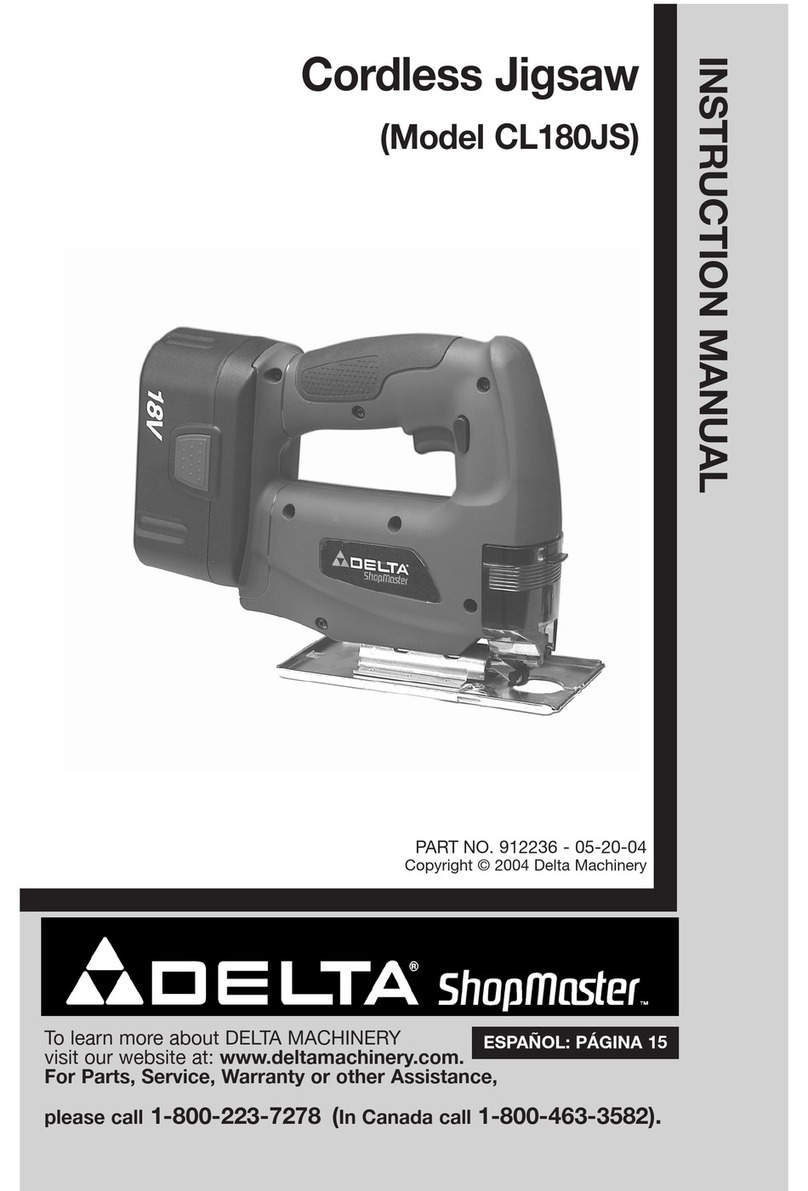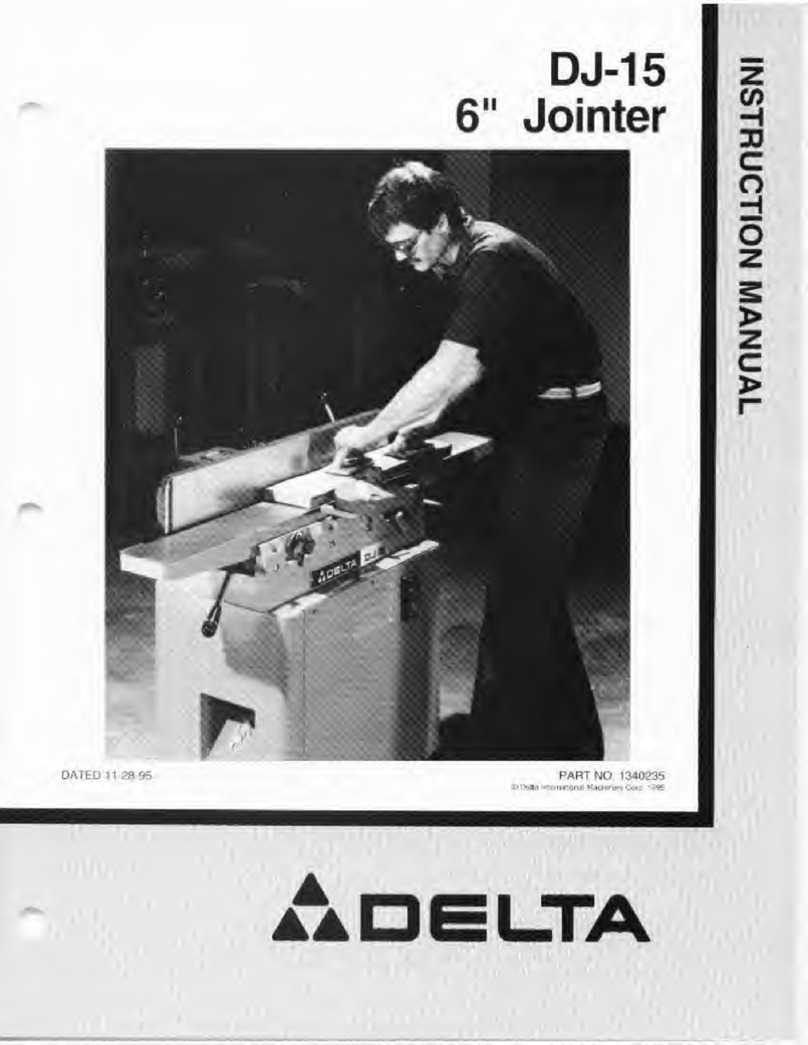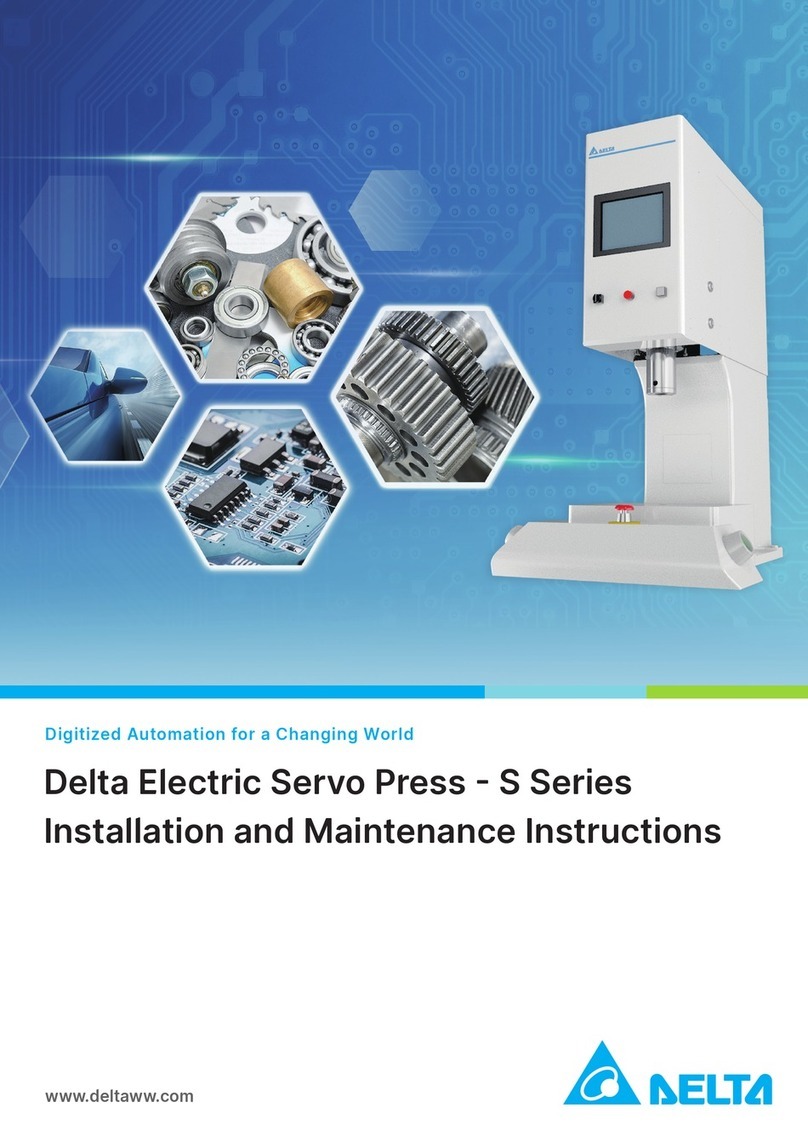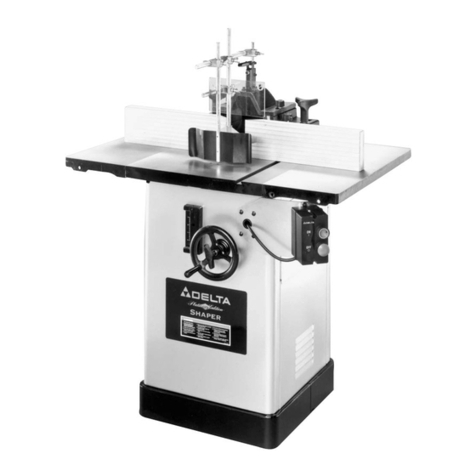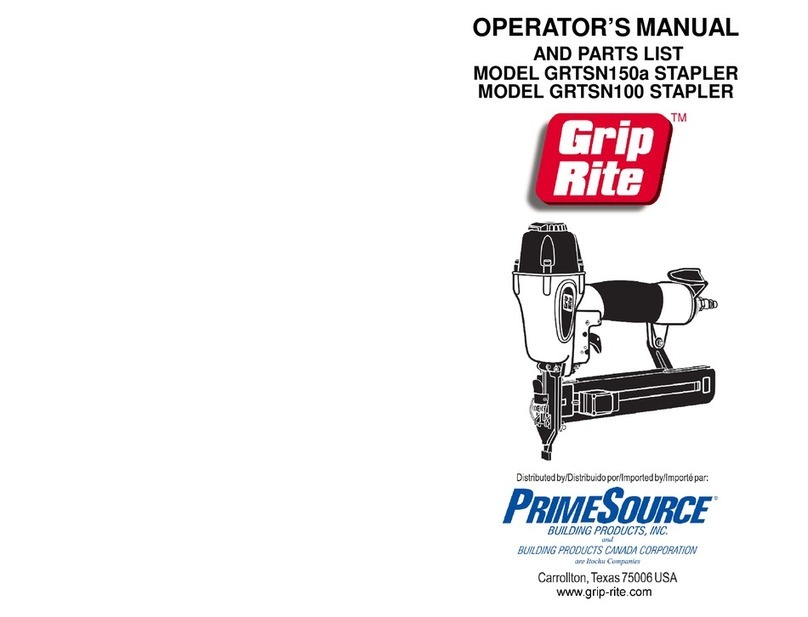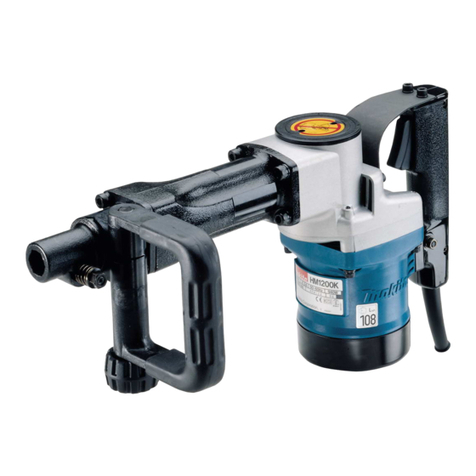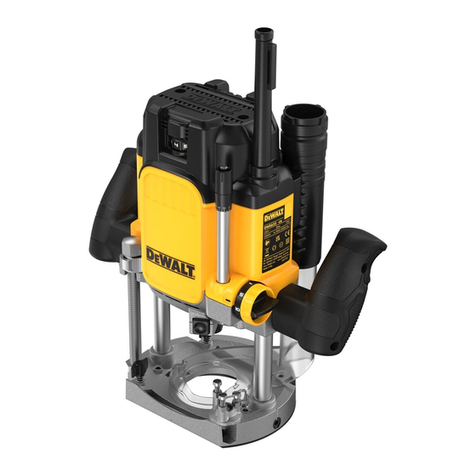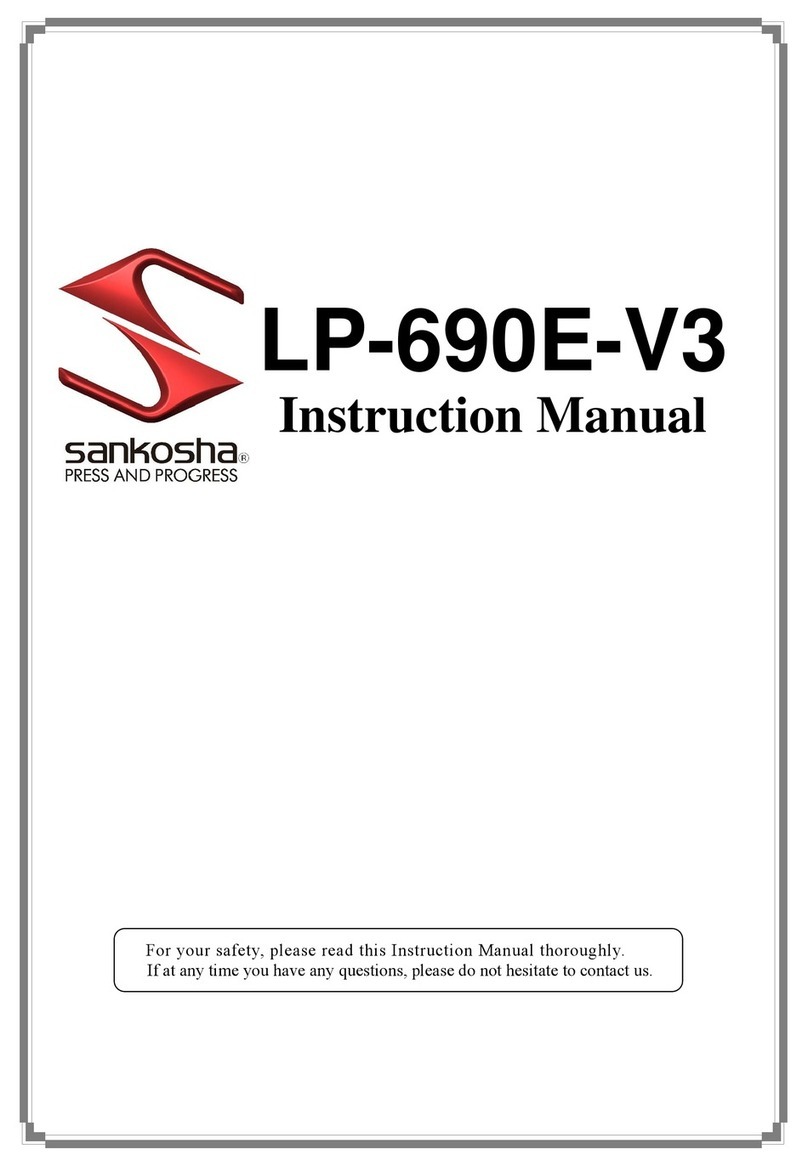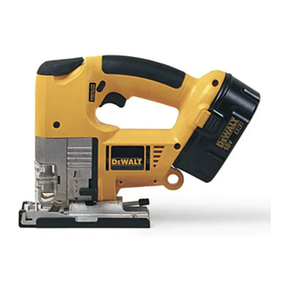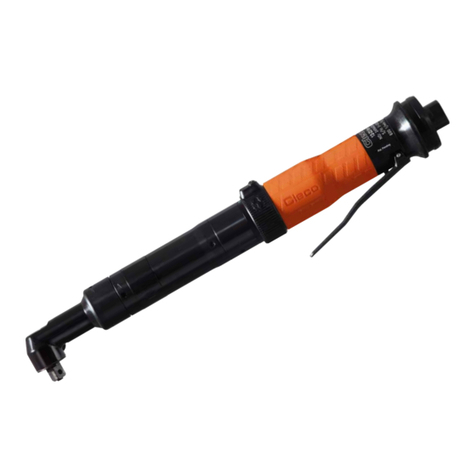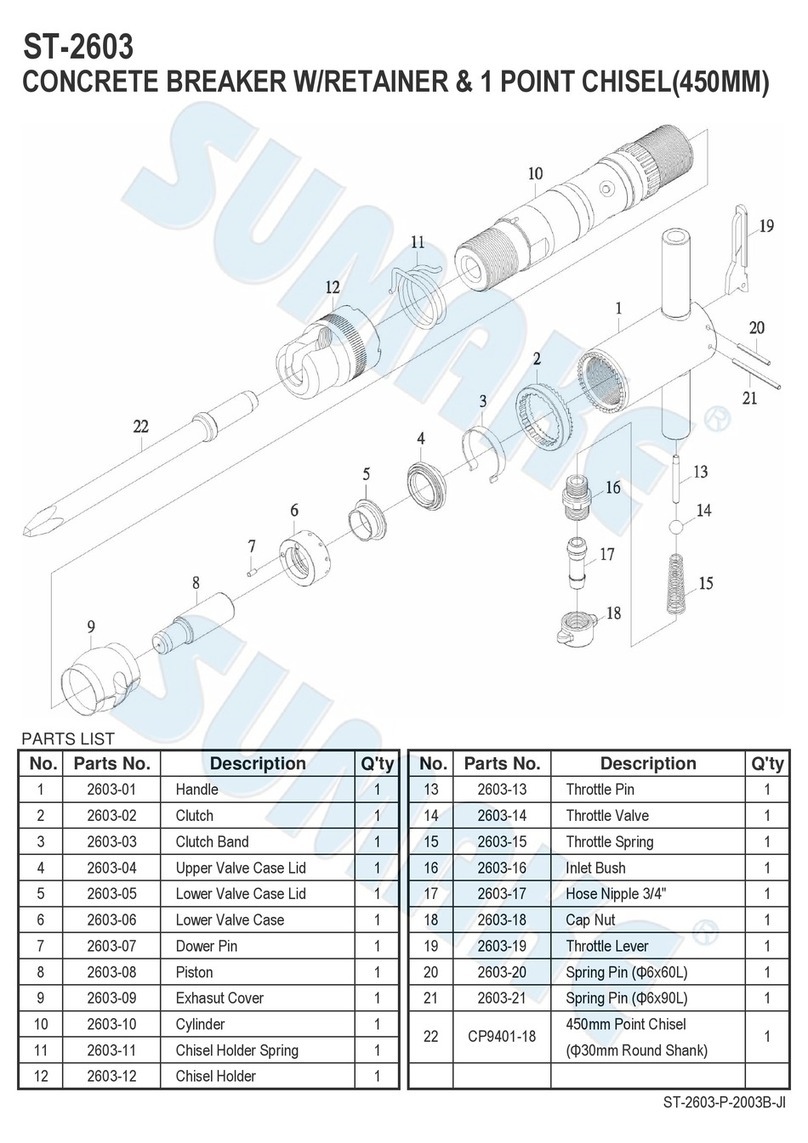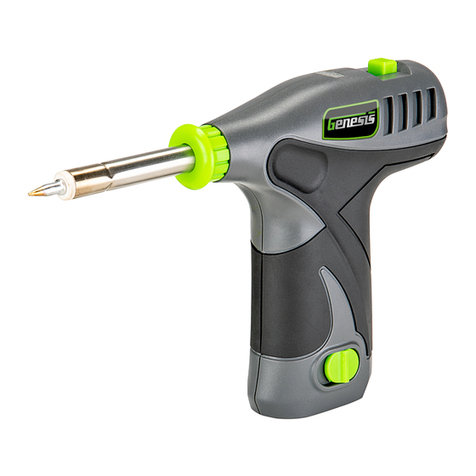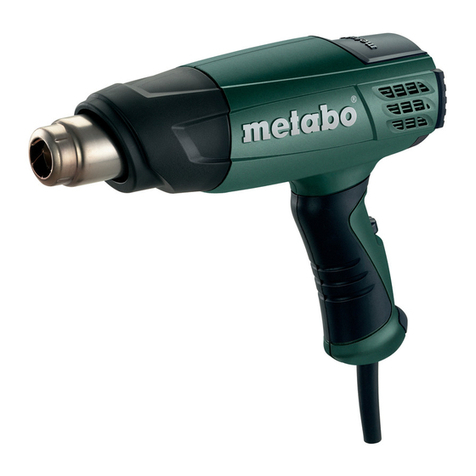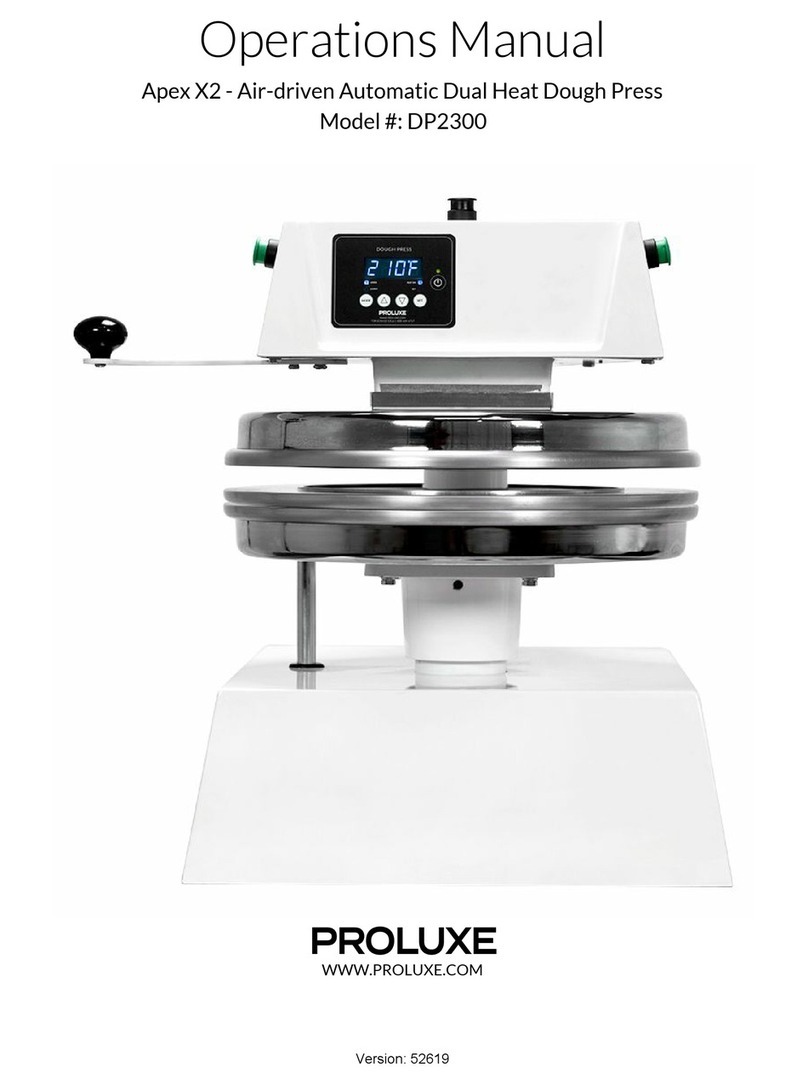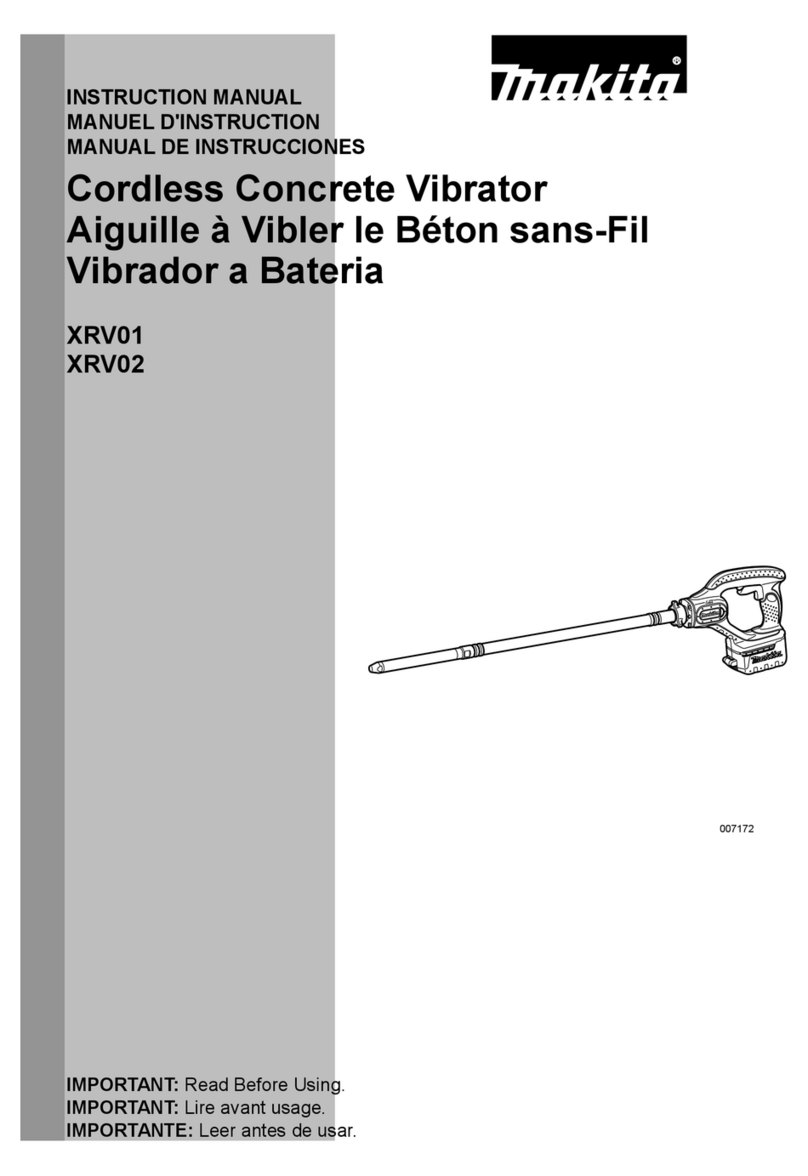Delta ShopMaster JT160 User manual

INSTRUCTION MANUAL
To learn more about DELTA MACHINERY
visit our website at: www.deltamachinery.com.
For Parts, Service, Warranty or other Assistance,
please call 1-800-223-7278 (In Canada call 1-800-463-3582).
6" Variable Speed
Bench Jointer
(Model JT160)
PART NO. A05756 - 09-09-04
Copyright © 2004 Delta Machinery
ESPAÑOL: PÁGINA 21
62223
RTD10000128AA

2
TABLE OF CONTENTS
Read and understand all warnings and operating instructions before using any tool or equipment. When
using tools or equipment, basic safety precautions should always be followed to reduce the risk of personal injury.
Improper operation, maintenance or modification of tools or equipment could result in serious injury and property
damage. There are certain applications for which tools and equipment are designed. Delta Machinery strongly
recommends that this product NOT be modified and/or used for any application other than for which it was designed.
If you have any questions relative to its application DO NOT use the product until you have written Delta Machinery
and we have advised you.
Online contact form at www.deltamachinery.com
Postal Mail: Technical Service Manager
Delta Machinery
4825 Highway 45 North
Jackson, TN 38305
Information regarding the safe and proper operation of this tool is available from the following sources:
Power Tool Institute
1300 Sumner Avenue, Cleveland, OH 44115-2851
www.powertoolinstitute.org
National Safety Council
1121 Spring Lake Drive, Itasca, IL 60143-3201
American National Standards Institute, 25 West 43rd Street, 4 floor, New York, NY 10036 www.ansi.org
ANSI 01.1Safety Requirements for Woodworking Machines, and
the U.S. Department of Labor regulations www.osha.gov
IMPORTANT SAFETY INSTRUCTIONS
SAVE THESE INSTRUCTIONS!
IMPORTANT SAFETY INSTRUCTIONS . . . . . . . . . . . . . . . . . . . . . . . . . . . . . . . . . . . . . . . . . . . . . . . . . . . . . . . . . . .2
SAFETY GUIDELINES . . . . . . . . . . . . . . . . . . . . . . . . . . . . . . . . . . . . . . . . . . . . . . . . . . . . . . . . . . . . . . . . . . . . . . . .3
GENERAL SAFETY RULES . . . . . . . . . . . . . . . . . . . . . . . . . . . . . . . . . . . . . . . . . . . . . . . . . . . . . . . . . . . . . . . . . . . .4
ADDITIONAL SPECIFIC SAFETY RULES . . . . . . . . . . . . . . . . . . . . . . . . . . . . . . . . . . . . . . . . . . . . . . . . . . . . . . . . .5
FUNCTIONAL DESCRIPTION . . . . . . . . . . . . . . . . . . . . . . . . . . . . . . . . . . . . . . . . . . . . . . . . . . . . . . . . . . . . . . . . . .7
CARTON CONTENTS . . . . . . . . . . . . . . . . . . . . . . . . . . . . . . . . . . . . . . . . . . . . . . . . . . . . . . . . . . . . . . . . . . . . . . . . .8
ASSEMBLY . . . . . . . . . . . . . . . . . . . . . . . . . . . . . . . . . . . . . . . . . . . . . . . . . . . . . . . . . . . . . . . . . . . . . . . . . . . . . . . . .9
OPERATION . . . . . . . . . . . . . . . . . . . . . . . . . . . . . . . . . . . . . . . . . . . . . . . . . . . . . . . . . . . . . . . . . . . . . . . . . . . . . . .12
TROUBLESHOOTING . . . . . . . . . . . . . . . . . . . . . . . . . . . . . . . . . . . . . . . . . . . . . . . . . . . . . . . . . . . . . . . . . . . . . . .17
MAINTENANCE . . . . . . . . . . . . . . . . . . . . . . . . . . . . . . . . . . . . . . . . . . . . . . . . . . . . . . . . . . . . . . . . . . . . . . . . . . . . .18
ACCESSORIES . . . . . . . . . . . . . . . . . . . . . . . . . . . . . . . . . . . . . . . . . . . . . . . . . . . . . . . . . . . . . . . . . . . . . . . . . . . .19
SERVICE . . . . . . . . . . . . . . . . . . . . . . . . . . . . . . . . . . . . . . . . . . . . . . . . . . . . . . . . . . . . . . . . . . . . . . . . . . . . . . . . . .19
WARRANTY . . . . . . . . . . . . . . . . . . . . . . . . . . . . . . . . . . . . . . . . . . . . . . . . . . . . . . . . . . . . . . . . . . . . . . . . . . . . . . . .20
ESPAÑOL . . . . . . . . . . . . . . . . . . . . . . . . . . . . . . . . . . . . . . . . . . . . . . . . . . . . . . . . . . . . . . . . . . . . . . . . . . . . . . . . . .21
SERVICE CENTER LOCATIONS . . . . . . . . . . . . . . . . . . . . . . . . . . . . . . . . . . . . . . . . . . . . . . . . . . . . . . . .back cover

3
Indicates an imminently hazardous situation which, if not avoided, will result in death or serious injury.
Indicates a potentially hazardous situation which, if not avoided, could result in death or serious injury.
Indicates a potentially hazardous situation which, if not avoided, may result in minor or moderate injury.
Used without the safety alert symbol indicates potentially hazardous situation which, if not avoided, may
result in property damage.
It is important for you to read and understand this manual. The information it contains relates to protecting YOUR
SAFETY and PREVENTING PROBLEMS. The symbols below are used to help you recognize this information.
SAFETY GUIDELINES - DEFINITIONS
SOME DUST CREATED BY POWER SANDING, SAWING, GRINDING, DRILLING, AND OTHER
CONSTRUCTION ACTIVITIES contains chemicals known to cause cancer, birth defects or other reproductive harm.
Some examples of these chemicals are:
· lead from lead-based paints,
· crystalline silica from bricks and cement and other masonry products, and
· arsenic and chromium from chemically-treated lumber.
Your risk from these exposures varies, depending on how often you do this type of work. To reduce your exposure to
these chemicals: work in a well ventilated area, and work with approved safety equipment, always wear MSHA/NIOSH
approved, properly fitting face mask or respirator when using such tools.
CALIFORNIA PROPOSITION 65

4
1. FOR YOUR OWN SAFETY, READ THE INSTRUCTION
MANUAL BEFORE OPERATING THE MACHINE.
Learning the machine’s application, limitations, and
specific hazards will greatly minimize the possibility of
accidents and injury.
2. WEAR EYE PROTECTION. ALWAYS USE SAFETY
GLASSES. Also use face or dust mask if cutting
operation is dusty. Everyday eyeglasses are NOT safety
glasses. USE CERTIFIED SAFETY EQUIPMENT. Eye
protection equipment should comply with ANSI Z87.1
standards, hearing equipment should comply with
ANSI S3.19 standards, and dust mask protection
should comply with MSHA/NIOSH certified respirator
standards. Splinters, air-borne debris, and dust can
cause irritation, injury, and/or illness.
3. WEAR PROPER APPAREL. Do not wear loose
clothing, gloves, neckties, rings, bracelets, or other
jewelry which may get caught in moving parts. Nonslip
footwear is recommended. Wear protective hair
covering to contain long hair.
4. DO NOT USE THE MACHINE IN A DANGEROUS
ENVIRONMENT. The use of power tools in damp or
wet locations or in rain can cause shock or
electrocution. Keep your work area well-lit to prevent
tripping or placing arms, hands, and fingers in danger.
5. MAINTAIN ALL TOOLS AND MACHINES IN PEAK
CONDITION. Keep tools sharp and clean for best and safest
performance. Follow instructions for lubricating and changing
accessories. Poorly maintained tools and machines can further
damage the tool or machine and/or cause injury.
6. CHECK FOR DAMAGED PARTS. Before using the
machine, check for any damaged parts. Check for
alignment of moving parts, binding of moving parts,
breakage of parts, and any other conditions that may
affect its operation. A guard or any other part that is
damaged should be properly repaired or replaced.
Damaged parts can cause further damage to the
machine and/or injury.
7. KEEP THE WORK AREA CLEAN. Cluttered areas and
benches invite accidents.
8. KEEP CHILDREN AND VISITORS AWAY. Your shop is a
potentially dangerous environment. Children and visitors can
be injured.
9. REDUCE THE RISK OF UNINTENTIONAL STARTING.
Make sure that the switch is in the “OFF” position
before plugging in the power cord. In the event of a
power failure, move the switch to the “OFF” position.
An accidental start-up can cause injury.
10. USE THE GUARDS. Check to see that all guards are in
place, secured, and working correctly to prevent injury.
11. REMOVE ADJUSTING KEYS AND WRENCHES
BEFORE STARTING THE MACHINE. Tools, scrap
pieces, and other debris can be thrown at high speed,
causing injury.
12. USE THE RIGHT MACHINE. Don’t force a machine or
an attachment to do a job for which it was not
designed. Damage to the machine and/or injury may
result.
13. USE RECOMMENDED ACCESSORIES. The use of
accessories and attachments not recommended by
Delta may cause damage to the machine or injury to the
user.
14. USE THE PROPER EXTENSION CORD. Make sure
your extension cord is in good condition. When using
an extension cord, be sure to use one heavy enough to
carry the current your product will draw. An undersized
cord will cause a drop in line voltage, resulting in loss of
power and overheating. See the Extension Cord Chart
for the correct size depending on the cord length and
nameplate ampere rating. If in doubt, use the next
heavier gauge. The smaller the gauge number, the
heavier the cord.
15. SECURE THE WORKPIECE. Use clamps or a vise to hold
the workpiece when practical. Loss of control of a
workpiece can cause injury.
16. FEED THE WORKPIECE AGAINST THE DIRECTION OF
THE ROTATION OF THE BLADE, CUTTER, OR ABRASIVE
SURFACE. Feeding it from the other direction will cause
the workpiece to be thrown out at high speed.
17. DON’T FORCE THE WORKPIECE ON THE MACHINE.
Damage to the machine and/or injury may result.
18. DON’T OVERREACH. Loss of balance can make you
fall into a working machine, causing injury.
19. NEVER STAND ON THE MACHINE. Injury could occur if the
tool tips, or if you accidentally contact the cutting tool.
20. NEVER LEAVE THE MACHINE RUNNING UNATTENDED.
TURN THE POWER OFF. Don’t leave the machine until it
comes to a complete stop. A child or visitor could be injured.
21. TURN THE MACHINE “OFF”, AND DISCONNECT THE
MACHINE FROM THE POWER SOURCE before installing
or removing accessories, before adjusting or changing
set-ups, or when making repairs. An accidental start-up
can cause injury.
22. MAKE YOUR WORKSHOP CHILDPROOF WITH
PADLOCKS, MASTER SWITCHES, OR BY
REMOVING STARTER KEYS. The accidental start-up
of a machine by a child or visitor could cause injury.
23. STAY ALERT, WATCH WHAT YOU ARE DOING, AND
USE COMMON SENSE. DO NOT USE THE
MACHINE WHEN YOU ARE TIRED OR UNDER THE
INFLUENCE OF DRUGS, ALCOHOL, OR MEDICAT-
ION. A moment of inattention while operating power
tools may result in injury.
24. TAKE PRECAUTIONS AGAINST DUST INHALATION.
The dust generated by certain woods and wood
products can be injurious to your health. Always
operate machinery in well-ventilated areas, and provide
for proper dust removal. Use wood dust collection
systems whenever possible.
GENERAL SAFETY RULES
READ AND UNDERSTAND ALL WARNINGS AND OPERATING INSTRUCTIONS BEFORE
USING THIS EQUIPMENT. Failure to follow all instructions listed below, may result in electric shock,
fire, and/or serious personal injury or property damage.
IMPORTANT SAFETY INSTRUCTIONS

5
ADDITIONAL SAFETY RULES FOR JOINTERS
1. DO NOT OPERATE THIS MACHINE until it is
completely assembled and installed according to the
instructions. A machine incorrectly assembled can
cause serious injury.
2. OBTAIN ADVICE from your supervisor, instructor, or
another qualified person if you are not thoroughly
familiar with the operation of this machine.
Knowledge is safety.
3. FOLLOW ALL WIRING CODES and recommended
electrical connections to prevent shock or
electrocution.
4. KEEP KNIVES SHARP and free from rust and pitch.
Dull or rusted knives work harder and can cause
kickback.
5. TIGHTEN THE INFEED/OUTFEED TABLES before
starting the machine. Loss of control of the work-
piece can cause serious injury.
6. PROPERLY SECURE THE BLADES IN THE CUTTERHEAD
before turning the power “ON”. Loose blades may be
thrown out at high speeds.
7. NEVER TURN THE MACHINE “ON” before clearing the
table of all objects (tools, scraps of wood, etc.). Flying
debris can cause serious injury.
8. NEVER TURN THE MACHINE “ON” with the workpiece
contacting the cutterhead. Kickback can occur.
9. AVOID AWKWARD OPERATIONS AND HAND
POSITIONS. A sudden slip could cause a hand to
move into the cutterhead.
10. KEEP ARMS, HANDS, AND FINGERS away from
the cutterhead to prevent severe injury.
11. NEVER MAKE CUTS deeper than 1/8" (3.2mm) to
prevent kickback.
12. NEVER JOINT OR PLANE A WORKPIECE that is
shorter than 10" (254mm), narrower than 3/4"
(19.0MM), or less than 1/2" (12.7mm) thick. Jointing
smaller workpieces can place your hand in the
cutterhead causing severe injury.
13. USE HOLD-DOWN/PUSH BLOCKS for jointing or
planing any workpiece lower than the fence. Jointing
or planing small workpieces can result in kickback
and severe injury.
14. HOLD THE WORKPIECE FIRMLY against the table
and fence. Loss of control of the workpiece can
cause kickback and result in serious injury.
15. NEVER PERFORM “FREE-HAND” OPERATIONS. Use
the fence to position and guide the workpiece. Loss
of control of the workpiece can cause serious injury.
16. DO NOT attempt to perform an abnormal or little-
used operation without study and the use of
adequate hold-down/push blocks, jigs, fixtures,
stops, etc.
17. DO NOT FEED A WORKPIECE into the outfeed end
of the machine.The workpiece will be thrown out of
the opposite end at high speeds.
18. DO NOT FEED A WORKPIECE that is warped,
contains knots, or is embedded with foreign objects
(nails, staples, etc.) to prevent kickback.
19. MAINTAIN THE PROPER RELATIONSHIP OF
INFEED AND OUTFEED TABLE SURFACES and
cutterhead knife path. Loss of control of the work-
piece can cause serious injury.
20. PROPERLY SUPPORT LONG OR WIDE WORKPIECES.
Loss of control of the workpiece can cause injury.
21. NEVER PERFORM LAYOUT, ASSEMBLY, OR SET-
UP WORK on the table/work area when the
machine is running. A sudden slip could cause a
hand to move into the cutterhead. Severe injury
can result.
22. TURN THE MACHINE “OFF”, disconnect the
machine from the power source, and clean the
table/work area before leaving the machine. LOCK
THE SWITCH IN THE “OFF” POSITION to prevent
unauthorized use. Someone else might accidentally
start the machine and cause injury to themselves.
23. ADDITIONAL INFORMATION regarding the safe
and proper operation of power tools (i.e. a safety
video) is available from the Power Tool Institute,
1300 Sumner Avenue, Cleveland, OH 44115-2851
(www.powertoolinstitute.com). Information is also
available from the National Safety Council, 1121
Spring Lake Drive, Itasca, IL 60143-3201. Please
refer to the American National Standards Institute
ANSI 01.1 Safety Requirements for Woodworking
Machines and the U.S. Department of Labor OSHA
1910.213 Regulations.
FAILURE TO FOLLOW THESE RULES MAY RESULT IN SERIOUS INJURY.
SAVE THESE INSTRUCTIONS.
Refer to them often
and use them to instruct others.

6
A separate electrical circuit should be used for your machines. This circuit should not be less than #12 wire and should
be protected with a 20 Amp time lag fuse. If an extension cord is used, use only 3-wire extension cords which have 3-
prong grounding type plugs and matching receptacle which will accept the machine’s plug. Before connecting the
machine to the power line, make sure the switch (s) is in the “OFF” position and be sure that the electric current is of
the same characteristics as indicated on the machine. All line connections should make good contact. Running on low
voltage will damage the machine.
DO NOT EXPOSE THE MACHINE TO RAIN OR OPERATE THE MACHINE IN DAMP LOCATIONS.
Fig. A Fig. B
GROUNDED OUTLET BOX
CURRENT
CARRYING
PRONGS
GROUNDING BLADE
IS LONGEST OF THE 3 BLADES
GROUNDED OUTLET BOX
GROUNDING
MEANS
ADAPTER
2. Grounded, cord-connected machines intended for
use on a supply circuit having a nominal rating less
than 150 volts:
If the machine is intended for use on a circuit that has an
outlet that looks like the one illustrated in Fig. A,the
machine will have a grounding plug that looks like the plug
illustrated in Fig. A.A temporary adapter, which looks like
the adapter illustrated in Fig. B, may be used to connect
this plug to a matching 2-conductor receptacle as shown
in Fig. B if a properly grounded outlet is not available. The
temporary adapter should be used only until a properly
grounded outlet can be installed by a qualified electrician.
The green-colored rigid ear, lug, and the like, extending
from the adapter must be connected to a permanent
ground such as a properly grounded outlet box. Whenever
the adapter is used, it must be held in place with a metal
screw.
NOTE: In Canada, the use of a temporary adapter is not
permitted by the Canadian Electric Code.
IN ALL CASES, MAKE CERTAIN THE
RECEPTACLE IN QUESTION IS PROPERLY
GROUNDED. IF YOU ARE NOT SURE HAVE A
QUALIFIED ELECTRICIAN CHECK THE RECEPTACLE.
1. All grounded, cord-connected machines:
In the event of a malfunction or breakdown, grounding
provides a path of least resistance for electric current to
reduce the risk of electric shock. This machine is
equipped with an electric cord having an equipment-
grounding conductor and a grounding plug. The plug must
be plugged into a matching outlet that is properly installed
and grounded in accordance with all local codes and
ordinances.
Do not modify the plug provided - if it will not fit the outlet,
have the proper outlet installed by a qualified electrician.
Improper connection of the equipment-grounding
conductor can result in risk of electric shock. The
conductor with insulation having an outer surface that is
green with or without yellow stripes is the equipment-
grounding conductor. If repair or replacement of the
electric cord or plug is necessary, do not connect the
equipment-grounding conductor to a live terminal.
Check with a qualified electrician or service personnel if
the grounding instructions are not completely
understood, or if in doubt as to whether the machine is
properly grounded.
Use only 3-wire extension cords that have 3-prong
grounding type plugs and matching 3-conductor
receptacles that accept the machine’s plug, as shown in
Fig. A.
Repair or replace damaged or worn cord immediately.
POWER CONNECTIONS
MOTOR SPECIFICATIONS
Your machine is wired for 120 volts, 60 HZ alternating current. Before connecting the machine to the power source,
make sure the switch is in the “OFF” position.
GROUNDING INSTRUCTIONS
THIS MACHINE MUST BE GROUNDED WHILE IN USE TO PROTECT THE OPERATOR FROM
ELECTRIC SHOCK.

7
EXTENSION CORDS
Use proper extension cords. Make sure
your extension cord is in good condition and is a 3-wire
extension cord which has a 3-prong grounding type
plug and matching receptacle which will accept the
machine’s plug. When using an extension cord, be sure
to use one heavy enough to carry the current of the
machine. An undersized cord will cause a drop in line
voltage, resulting in loss of power and overheating. Fig.
D-1 or D-2, shows the correct gauge to use depending
on the cord length. If in doubt, use the next heavier
gauge. The smaller the gauge number, the heavier the
cord.
Fig. D-1
MINIMUM GAUGE EXTENSION CORD
RECOMMENDED SIZES FOR USE WITH STATIONARY ELECTRIC MACHINES
Ampere Total Length Gauge of
Rating Volts of Cord in Feet Extension Cord
0-6 120
up to
25 18 AWG
0-6 120 25-50 16 AWG
0-6 120 50-100 16 AWG
0-6 120 100-150 14 AWG
6-10 120
up to
25 18 AWG
6-10 120 25-50 16 AWG
6-10 120 50-100 14 AWG
6-10 120 100-150 12 AWG
10-12 120
up to
25 16 AWG
10-12 120 25-50 16 AWG
10-12 120 50-100 14 AWG
10-12 120 100-150 12 AWG
12-16 120
up to
25 14 AWG
12-16 120 25-50 12 AWG
12-16 120 GREATER THAN 50 FEET NOT RECOMMENDED
FOREWORD
Delta ShopMaster Model JT160 is a 6" (152mm), Variable-Speed Bench Jointer with a designed cutting capacity of 6"
(152mm) width and 1/8" (3mm) depth. Unit includes a 10 amp, 120 volt motor with a variable speed range of 6000 to
11,000 rpm, and a cutting speed range of 12,000 to 22,000 cpm, a dust chute, a center-mounted fence, a two-knife
cutterhead, a cutterhead guard and lock, wrenches, and push blocks.
FUNCTIONAL DESCRIPTION
NOTICE: THE PHOTO ON THE MANUAL COVER ILLUSTRATES THE
CURRENT PRODUCTION MODEL. ALL OTHER ILLUSTRATIONS CONTAINED
IN THE MANUAL ARE REPRESENTATIVE ONLY AND MAY NOT DEPICT THE
ACTUAL COLOR, LABELING OR ACCESSORIES AND ARE INTENDED TO
ILLUSTRATE TECHNIQUE ONLY.

8
CARTON CONTENTS
1. Jointer
2. Fence
3. Cutterhead Guard
4. Fence Sliding Bracket
5. Fence Mounting Bracket
1
2
3
5
4
6
7 8
9
10
12
11
13 14
6. Push Blocks - (2)
7. M8 Flat Washer
8. Spring Loaded Lock Handle
9. M6x1x16mm Button Head Screw - (6)
10. 5/32 Hex Wrench
11. Special Nut
12. M6x1 Square Nut - (2)
13. 7/64 Hex Wrench
14. Cutterhead Lock
UNPACKING AND CLEANING
Carefully unpack the machine and all loose items from the shipping container(s). Remove the protective coating from
all unpainted surfaces. This coating may be removed with a soft cloth moistened with kerosene (do not use acetone,
gasoline or lacquer thinner for this purpose). After cleaning, cover the unpainted surfaces with a good quality household
floor paste wax.
Fig. 4 Fig. 4A

9
ASSEMBLY
ASSEMBLY TOOLS REQUIRED
ASSEMBLY TIME ESTIMATE - 30 minutes
FOR YOUR OWN SAFETY, DO NOT CONNECT THE MACHINE TO THE POWER SOURCE UNTIL THE
MACHINE IS COMPLETELY ASSEMBLED AND YOU READ AND UNDERSTAND THE ENTIRE
INSTRUCTION MANUAL.
Fig. 5 Fig. 6
Fig. 7 Fig. 8
FENCE
1. Assemble the fence mounting bracket (A) Fig. 5 to the jointer base using the four M6x1x16mm button head screws
(B) Fig. 6.
2. Assemble the fence sliding bracket (C) Fig. 7 to mounting bracket (A) using the lockhandle (D), M8 flat washer (E)
and special nut (F) Fig. 8.
A
BB
A
C
D
E
F
* Two hex wrenches (supplied)

10
Fig. 9 Fig. 10
Fig. 11 Fig. 12
3. Insert a M6x1x16mm button head screw (G) Fig. 9 through fence tilting bracket (H) and thread a M6x1 square nut
(J) onto threaded end of screw (G). DO NOT COMPLETELY TIGHTEN SCREW (G) AT THIS TIME. Assemble
screw and square nut to opposite end of tilting bracket in the same manner.
4. Slide groove of fence (L) Fig. 10 over square nuts (J).
5. Position fence (L) Fig. 11 so that rounded section (M) on bottom of fence is over cutterhead opening.
6. Tighten two screws (G) Fig. 12 using included hex wrench.
H
J
G
J
L
L
M
GG
CUTTERHEAD GUARD
1. Locate the two M6x1x12mm button head screws (A) Fig. 13 in front side of jointer base. MAKE SURE THEY ARE
NOT COMPLETELY TIGHTENED AT THIS TIME.
2. Slide guard mounting bracket (B) Fig. 14 onto the two screws (A). Make sure cutterhead guard is touching the fence
and tighten the two screws (A).
Fig. 13
A
Fig. 14
AA
B

11
Fig. 15 Fig. 16
CUTTERHEAD LOCK
Assemble cutterhead lock (A) Fig. 15 to the front side of the jointer base, using the M6x1x12mm button head screw
(B).
NOTE: THE CUTTERHEAD LOCK (A) IS TO BE ENGAGED WITH THE CUTTERHEAD SHAFT (FIG. 15) ONLY WHEN
SETTING KNIVES. ALL OTHER TIMES, THE CUTTERHEAD LOCK (A) SHOULD BE DISENGAGED FROM THE
CUTTERHEAD (FIG. 16).
A
B
A
FASTENING JOINTER TO SUPPORTING SURFACE
If during operation, there is any tendency for the jointer
to tip over, slide or “walk” on the supporting surface, the
jointer must be secured to the supporting surface. Four
holes (two of which are shown at (A) Fig. 20), are
provided for this purpose.
Fig. 20
AA

VARIABLE SPEED CONTROL
Your jointer is supplied with variable speed control (A)
Fig. 23A that enables you to operate the machine at
cutterhead speeds between 6000 and 11,000 RPM.
Speed indicators of 1-2-3-4 and 5 are provided on the
speed dial. When the pointer (B) is pointing to 1, the
cutterhead speed will be 6000 RPM; 2 – 7250 RPM; 3 –
8800 RPM; 4 – 9750 RPM; and 5 – 11,000 RPM.
SPEED SELECTION CHART
Use the speed selection chart (Fig. 23) to determine the
proper setting for your workpiece.
NOTE: For convenience, make a copy of this chart and
post it on or near the machine.
Fig. 23B
Fig. 21 Fig. 22
A
B
OPERATION
STARTING AND STOPPING JOINTER
1. The on/off switch (A) Fig. 21 is located on the front of the jointer. To turn the machine “ON”, move switch (A) up
to the “ON” position.
2. To turn the machine “OFF”, move the switch down to the “OFF” position.
MAKE SURE THAT THE SWITCH IS IN THE “OFF” POSITION BEFORE PLUGGING IN THE POWER
CORD. IN THE EVENT OF A POWER FAILURE, MOVE THE SWITCH TO THE “OFF” POSITION. AN ACCIDENTAL
START-UP CAN CAUSE INJURY.
LOCKING SWITCH IN THE “OFF” POSITION
IMPORTANT: When the tool is not in use, the switch should be locked in the “OFF” position to prevent
unauthorized use. To lock the switch, grasp the switch toggle (B) Fig. 22 and pull it out of the switch. With the switch
toggle (B) removed, the switch will not operate. However, should the switch toggle be removed while the saw is
running, the machine can be turned “OFF,” but cannot be restarted without re-inserting the switch toggle (B).
OPERATIONAL CONTROLS AND ADJUSTMENTS
12
Fig. 23A
A

13
DEPTH OF CUT ADJUSTMENT
The jointer can be set to cut any depth from a very thin
shaving to 1/8" deep. A dual English/Metric scale (A)
Fig. 24, and pointer (B) are provided to indicate the depth
of cut. To adjust for depth of cut, loosen lock knob (C)
and turn adjusting knob (D) clockwise to lower and coun-
terclockwise to raise the infeed table. Raising the infeed
table decreases the depth of cut, while lowering it will
increase the depth. After the infeed table is at the desired
setting, tighten lock knob (C).
NOTE: For best results, final positioning of the infeed
table should always be made from the bottom to the up
position.
FENCE ADJUSTMENTS
The fence can be moved across the table and can be
tilted up to 45 degrees, as follows:
1. To move the fence across the table, loosen lock lever
(A) Fig. 25, slide the fence to the desired position on the
table and tighten lever (A).
NOTE: Lock lever (A) is spring loaded and can be
repositioned by pulling up on the lever and repositioning
it on the nut located underneath the lever.
2. To tilt the fence, loosen lever (B) Fig. 25, and tilt the
fence to the desired angle. Then tighten lever (B).
NOTE: Lever (B) is spring loaded and can be
repositioned by pulling out on the lever and repositioning
it on the nut located underneath the lever.
3. The fence features adjustable positive stops at the
most used fence positions of 90 degrees and 45 degrees
to the right. To check and adjust the positive stops,
proceed as follows:
4. Place a square (C) Fig. 26, on the table with one end
of the square against the fence as shown. Adjust the
fence until it is exactly 90 degrees to the table.
Fig. 24
Fig. 25
A
B
C
D
B
A
Fig. 26
5. Using supplied hex wrench (No. 10, Fig. 4A), turn set
screw (D) Fig. 27 until it contacts stop (E).
C
D
E
Fig. 27

14
ADJUSTING KNIVES
When it becomes necessary to adjust the knives due to replacement or wear:
THE KNIVES ARE SHARP.
DISCONNECT MACHINE FROM POWER SOURCE.
1. REMOVE CUTTERHEAD GUARD
2. Make sure the cutterhead lock (A) Fig.30 is not engaged, rotate cutterhead and loosen four screws (B) Fig. 30.
NOTE: Do not overly loosen the screws (A). Loosen one half turn or only enough so knife can slide between locking
plate and cutterhead.
3. Rotate cutterhead and engage cutterhead lock (B) Fig. 31, on cutterhead shaft as shown. This will position knives
for proper adjustment to the outfeed table.
4. Place a straight edge (D) Fig. 31, on the outfeed table extending out over the knife as shown. Using wrench (C)
supplied, turn screw (E) until knife just touches straight edge. Adjust knife at near end of cutterhead in the same
manner turning screw (F). Tighten four screws (A) Fig. 30, after adjustment is made.
5. Adjust remaining knife in the same manner.
NOTE: Make sure cutterhead lock (B) is disengaged after adjustment is completed and replace cutterhead guard.
Fig. 30 Fig. 31
B
F
E
D
C
B
Fig. 28 Fig. 29
6. Using a square (C) Fig. 28, tilt the table to the 45 degree position and make sure the fence is 45 degrees to the
table. Adjust the fence if necessary.
7. Using supplied hex wrench (No. 10, Fig. 4A), turn set screw (H) Fig. 29, until it contacts stop (G).
8. These positive stops enable you to rapidly position the table to the 90 and 45 degree settings.
MAKE SURE THE FENCE IS IN LEVEL CONTACT WITH THE SURFACE OF THE OUTFEED TABLE.
C
H
G
A

15
6. If the knives are set too low, the result will be as
shown in Fig. 32, and the finished surface will be
curved.
7. If the knives are set too high, the work will be
gouged at the end of the cut, as shown in Fig. 33.
8. As a final check, run a piece of work slowly over the
knives for 6 to 8 inches. The wood should rest firmly
on both tables as shown in Fig. 34, with no open
spaces under the finished cut.
Fig. 32
Fig. 33
Fig. 34
KNIVES
SET TOO LOW
OUT-FEED
TABLE IN-FEED TABLE
CUTTER
MATERIAL
KNIVES
SET TOO HIGH
IN-FEED TABLE
OUT-FEED
TABL E
CUTTER
GOUGE
MATERIAL
IN-FEED TABLE
CUTTER
OUT-FEED
TABLE
KNIVES AT
CORRECT HEIGHT
MATERIAL
CHIP AND DUST CHUTE
A chip and dust chute (A) Fig. 35 is provided on the outfeed end of the jointer base for efficient chip removal.
KEEP HANDS OUT OF CHIP AND DUST CHUTE AT ALL TIMES.
PUSH BLOCKS
A set of push blocks (A) Fig. 36 is supplied with your jointer and should be used whenever possible to minimize all
danger to your hands. Fig. 36 illustrates using the push blocks properly.
Fig. 35
A
Fig. 36
A

The following directions will give the beginner a start on jointer operations. Use scrap pieces of lumber to check the
settings and to get the feel of the operations before attempting regular work.
NOTE: The knives on the jointer will not wear evenly by feeding the wood through the same spot on the table
every time. Feed the wood through the jointer at different spots on the table to help eliminate uneven wear of
the knives.
ALWAYS USE CUTTERHEAD GUARD AND KEEP HANDS AWAY FROM CUTTERHEAD. USE PUSH
BLOCKS WHENEVER POSSIBLE.
Fig. 37C
PLACEMENT OF HANDS
DURING FEEDING
At the start of the cut, the left hand holds the work firmly
against the infeed table and fence, while the right hand
pushes the work toward the knives. After the cut is un-
derway, the new surface rests firmly on the outfeed table
as shown in Fig. 37C. The left hand should then be
moved to the work on the outfeed table, at the same
time maintaining flat contact with the fence. The right
hand presses the work forward, and before the right
hand reaches the cutterhead it should be moved to the
work on the outfeed table.
NEVER PASS HANDS DIRECTLY
OVER THE CUTTERHEAD.
JOINTING AN EDGE
This is the most common operation for the jointer. Set
the guide fence square with the table. Depth of cut
should be the minimum required to obtain a straight
edge. Hold the best face of the piece firmly against the
fence throughout the feed as shown in Fig. 38.
DO NOT PERFORM JOINTING OPERA-
TIONS ON MATERIAL SHORTER THAN
10 INCHES (254 mm), NARROWER
THAN 3/4 INCH (19 mm), OR LESS
THAN 1/2 INCH (12.7 mm) THICK
(REFER TO FIG. 39).
Fig. 39
OUT-FEED
TABLE IN-FEED TABLE
CUTTER
MATERIAL
3/4" (19 mm) MINIMUM
10" (254 mm) MINIMUM
MINIMUM JOINTING DIMENSIONS
1/2" (12.7 mm)
MINIMUM
MACHINE USE
Fig. 37A Fig. 37B
1. JOINTING OPERATIONS – Jointing cuts or edge
jointing are made to square an edge of a workpiece.
The workpiece is positioned on the jointer with the
narrow edge of the workpiece on the infeed table
and the major flat surface of the workpiece against
the fence, as shown in Fig. 37A. The workpiece is
moved from the infeed table, across the cutterhead
to the outfeed table.
2. PLANING OPERATIONS – Planing or surfacing are
identical to the jointing operation except for the
position of the workpiece. For planing, the major flat
surface of the workpiece is placed on the infeed
table of the jointer with the narrow edge of the
workpiece against the fence, as shown in Fig. 37B.
The workpiece is moved from the infeed table,
across the cutterhead to the outfeed table. Use push
blocks when performing planing operations
whenever possible.
16
DEFINITION OF JOINTING, PLANING

17
PLANING WARPED PIECES
If the wood to be planed is dished or warped, take light
cuts until the surface is flat. Avoid forcing such material
down against the table; excessive pressure will spring it
while passing the knives, and it will spring back and
remain curved after the cut is completed.
PLANING SHORT OR THIN WORK
When planing short or thin pieces, always use push
blocks to minimize all danger to the hands. Fig. 40,
illustrates using the Push Blocks properly.
DO NOT PERFORM PLANING OPERA-
TIONS ON MATERIAL SHORTER THAN
10 INCHES (254 mm), NARROWER
THAN 3/4 INCH (19 mm), WIDER THAN
6 INCHES (152.4 mm) OR LESS THAN
1/2 INCH (12.7 mm) THICK
Fig. 40
Fig. 41
Fig. 42 Fig. 43
DIRECTION OF GRAIN
Avoid feeding work into the jointer against the grain as shown in Fig. 42. The result will be chipped and splintered
edges. Feed with the grain as shown in Fig. 43 to obtain a smooth surface.
MINIMUM AND MAXIMUM PLANING DIMENSIONS
1/2" (12.7 mm)
MINIMUM 3/4" (19mm) MINIMUM
6" (152.4 mm)
MAXIMUM
10" (254 mm) MINIMUM
IN-FEED TABLE
OUT-FEED
TABLE
CUTTER
WRONG FEED - AGAINST THE GRAIN
MATERIAL
CORRECT FEED - WITH THE GRAIN
IN-FEED TABLE
OUT-FEED
TABLE
CUTTER
MATERIAL
TROUBLESHOOTING
For assistance with your machine, visit our website at www.deltamachinery.com for a list of service centers or call
the DELTA Machinery help line at 1-800-223-7278 (In Canada call 1-800-463-3582).

18
Fig. 44
Fig. 45
BELT REPLACEMENT
When it becomes necessary to replace the belt on your
jointer:
DISCONNECT MACHINE FROM POWER
SOURCE.
1. Remove screw (A) Fig. 44, using hex wrench
supplied, and remove belt guard (B).
2. Loosen three screws (C) Fig. 45, to release belt
tension and remove belt (D) from pulleys.
3. Assemble new belt to the cutterhead and motor
pulleys. Press down on motor pulley (E) Fig. 45, to
tension belt and tighten three screws (C).
NOTE: THERE SHOULD BE APPROXIMATELY 1/4
INCH DEFLECTION IN THE BELT (D) AT THE
CENTER SPAN OF THE PULLEYS USING LIGHT
FINGER PRESSURE. THE BELT DOES NOT
REQUIRE EXCESSIVE TENSION TO FUNCTION
PROPERLY.
4. Replace belt guard (B) Fig. 44.
B
A
B
C
CC
D
E
MAINTENANCE
KEEP MACHINE CLEAN
Periodically blow out all air passages with dry compressed air. All plastic parts should be cleaned with a soft damp cloth.
NEVER use solvents to clean plastic parts. They could possibly dissolve or otherwise damage the material.
Wear ANSI Z87.1 safety glasses while using compressed air.
FAILURE TO START
Should your machine fail to start, check to make sure the prongs on the cord plug are making good contact in the outlet. Also,
check for blown fuses or open circuit breakers in the line.
LUBRICATION
Apply household floor paste wax to the machine table and extension table or other work surface weekly.
PROTECTING CAST IRON FROM RUST
To clean and protect cast iron tables from rust, you will need the following materials: 1 pushblock from a jointer, 1 sheet
of medium Scotch-Brite™ Blending Hand Pad, 1 can of WD-40®, 1 can of degreaser, 1 can of TopCote®Aerosol. Apply
the WD-40 and polish the table surface with the Scotch-Brite pad using the pushblock as a holddown. Degrease the
table, then apply the TopCote®accordingly.

19
A complete line of accessories is available from your Delta Supplier, Porter-Cable • Delta Factory Service Centers,
and Delta Authorized Service Stations. Please visit our Web Site www.deltamachinery.com for a catalog or
for the name of your nearest supplier.
Since accessories other than those offered by Delta have not been tested with this product, use of such
accessories could be hazardous. For safest operation, only Delta recommended accessories should be
used with this product.
ACCESSORIES
PARTS, SERVICE OR WARRANTY ASSISTANCE
All Delta Machines and accessories are manufactured to high quality standards and are serviced by a network
of Porter-Cable • Delta Factory Service Centers and Delta Authorized Service Stations. To obtain additional
information regarding your Delta quality product or to obtain parts, service, warranty assistance, or the location
of the nearest service outlet, please call 1-800-223-7278 (In Canada call 1-800-463-3582).
SERVICE

20
Two Year Limited New Product Warranty
Delta will repair or replace, at its expense and at its option, any new Delta machine, machine part, or machine accessory
which in normal use has proven to be defective in workmanship or material, provided that the customer returns the product
prepaid to a Delta factory service center or authorized service station with proof of purchase of the product within two
years and provides Delta with reasonable opportunity to verify the alleged defect by inspection. For all refurbished Delta
product, the warranty period is 180 days. Delta may require that electric motors be returned prepaid to a motor
manufacturer’s authorized station for inspection and repair or replacement. Delta will not be responsible for any asserted
defect which has resulted from normal wear, misuse, abuse or repair or alteration made or specifically authorized by
anyone other than an authorized Delta service facility or representative. Under no circumstances will Delta be liable for
incidental or consequential damages resulting from defective products. This warranty is Delta’s sole warranty and sets
forth the customer’s exclusive remedy, with respect to defective products; all other warranties, express or implied, whether
of merchantability, fitness for purpose, or otherwise, are expressly disclaimed by Delta.
WARRANTY
Table of contents
Other Delta Power Tools manuals
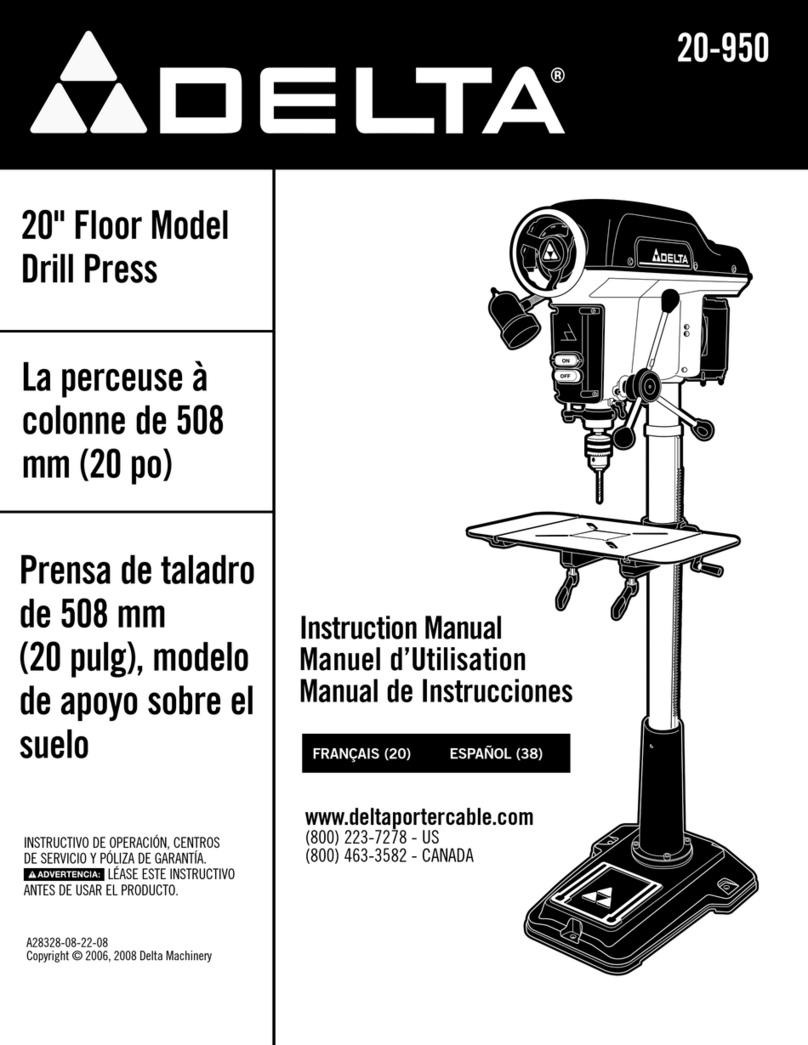
Delta
Delta 20-950 User manual
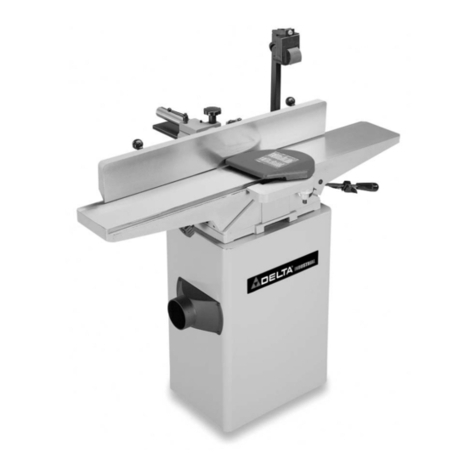
Delta
Delta 37-195 User manual
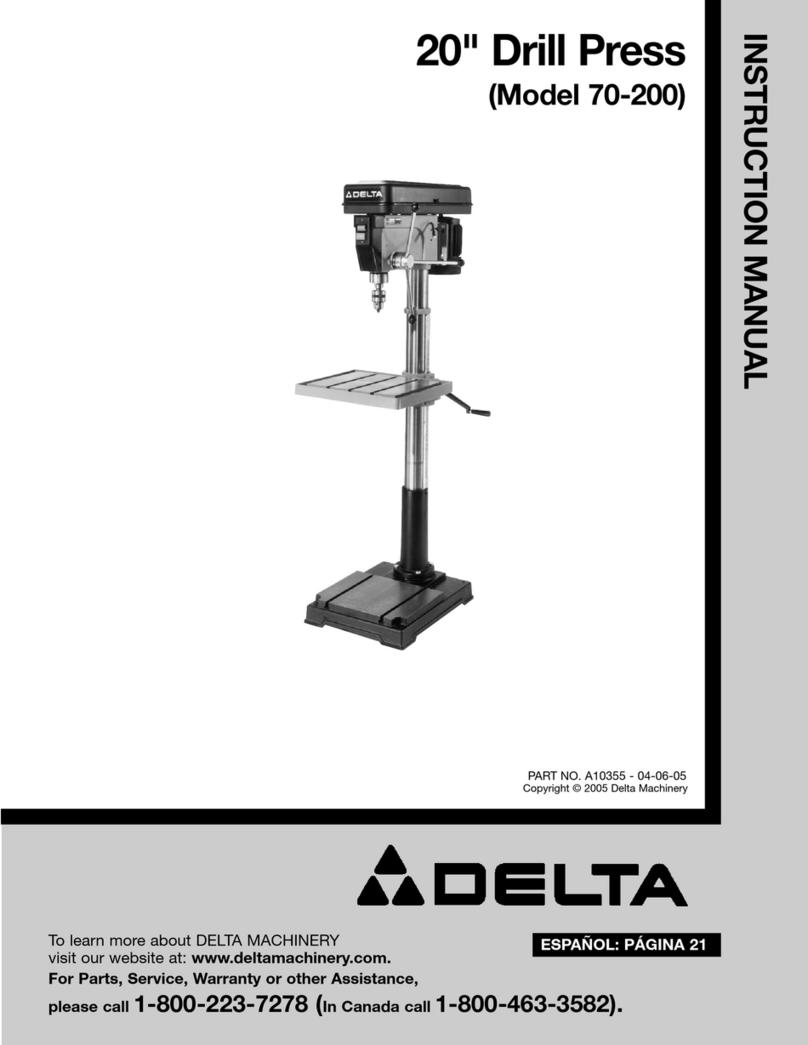
Delta
Delta 70-200 User manual
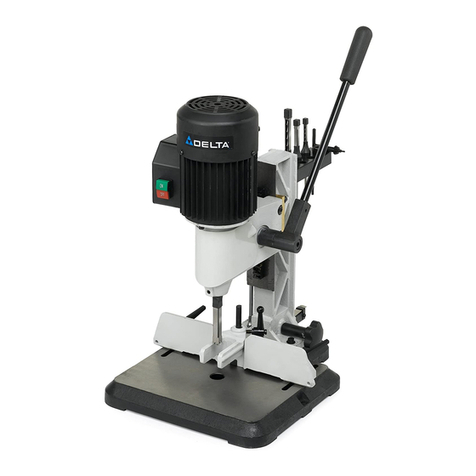
Delta
Delta 14-651 User manual
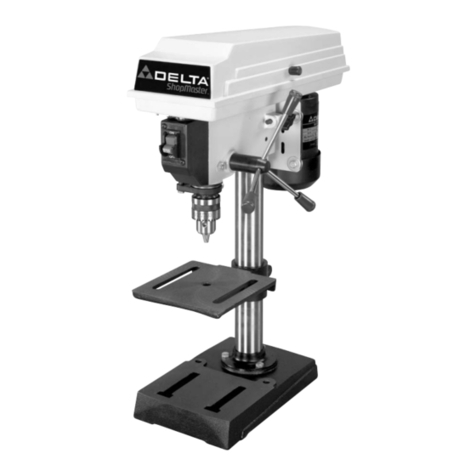
Delta
Delta ShopMaster DP115 User manual
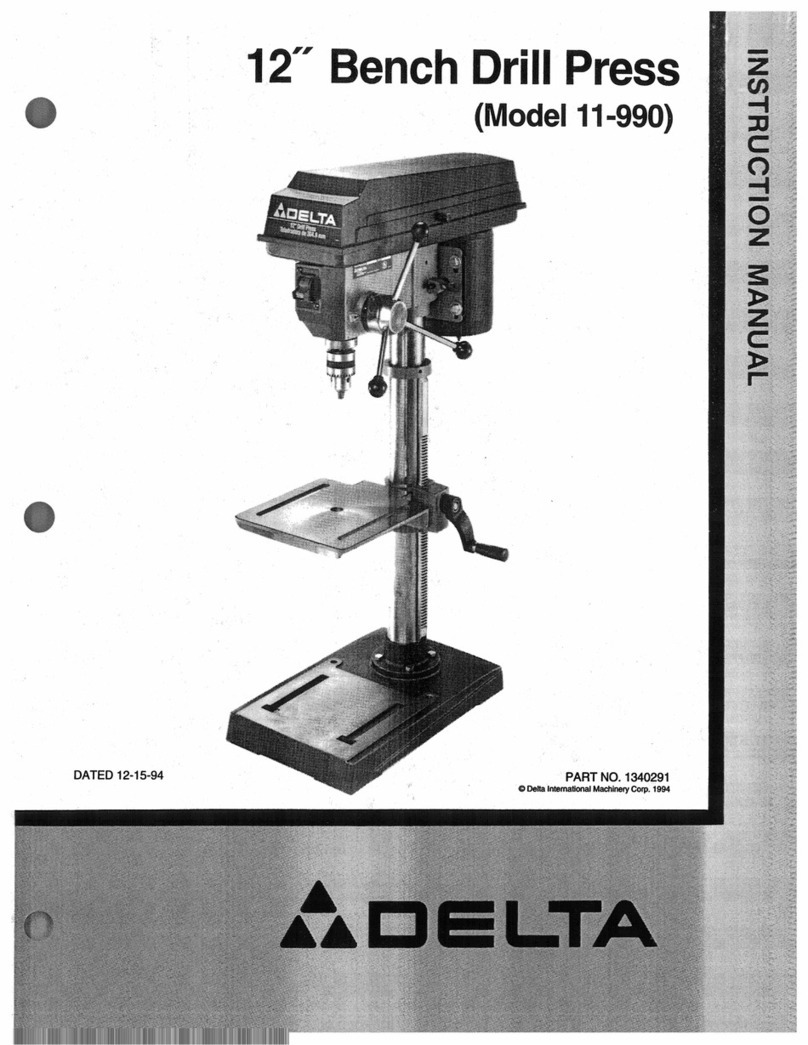
Delta
Delta 11-990 User manual

Delta
Delta ShopMaster DP250 User manual
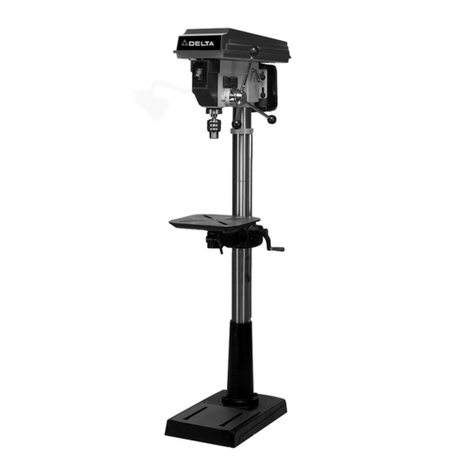
Delta
Delta 14-070 User manual
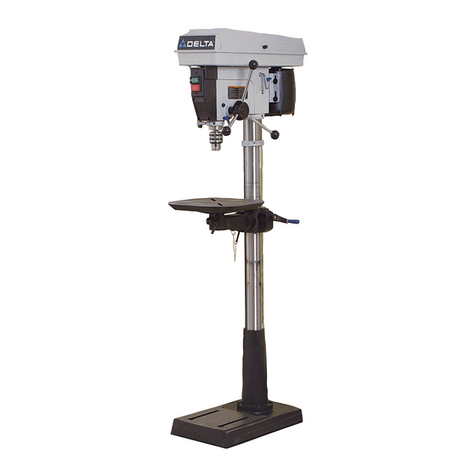
Delta
Delta 17-965 User manual

Delta
Delta 23-675 User manual
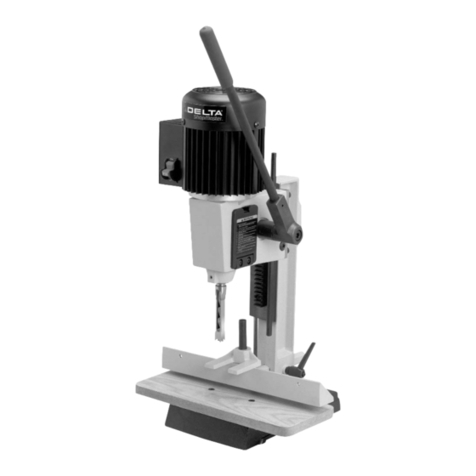
Delta
Delta ShopMaster MM300 User manual
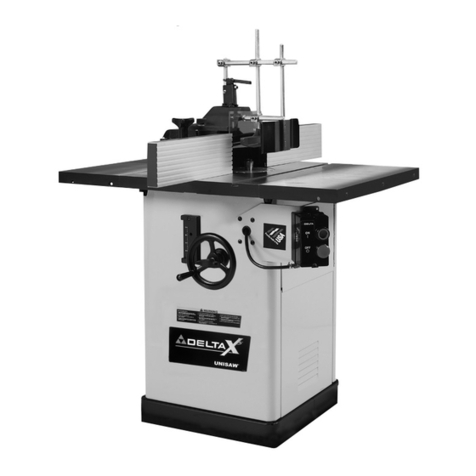
Delta
Delta 43-431 User manual
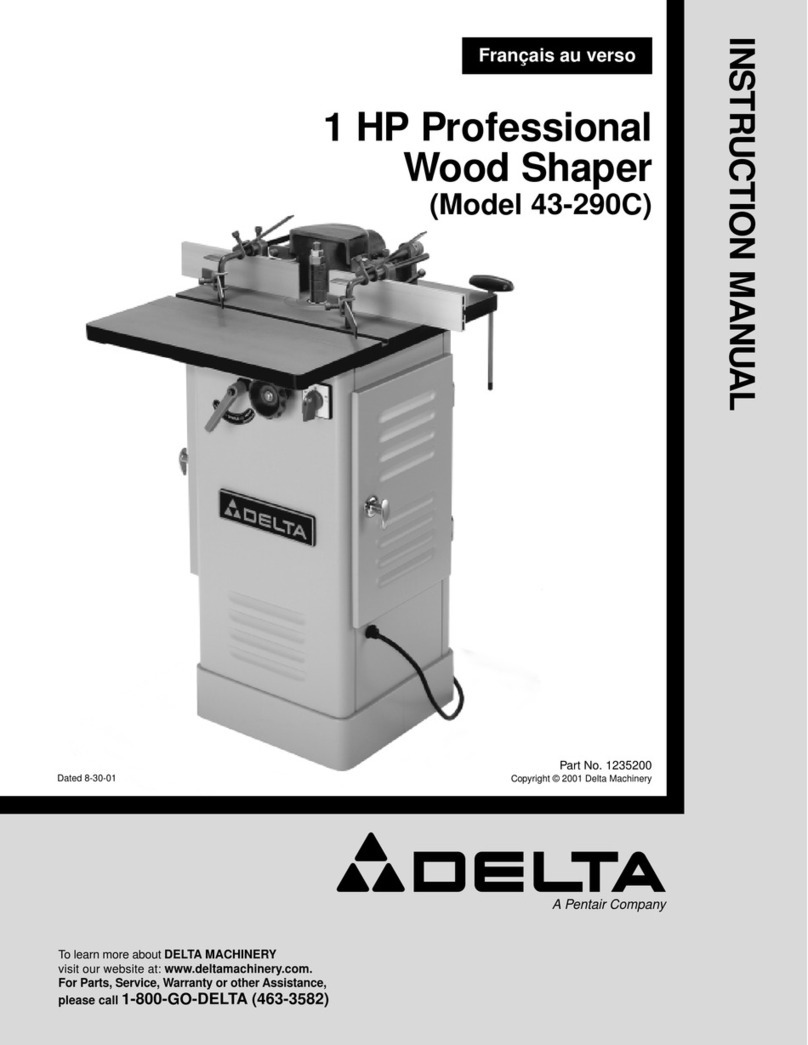
Delta
Delta 43-290C User manual
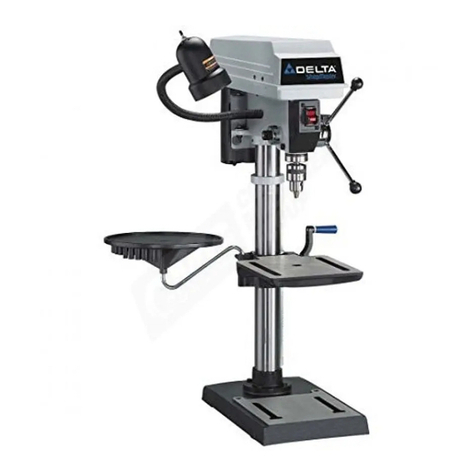
Delta
Delta DP300 User manual
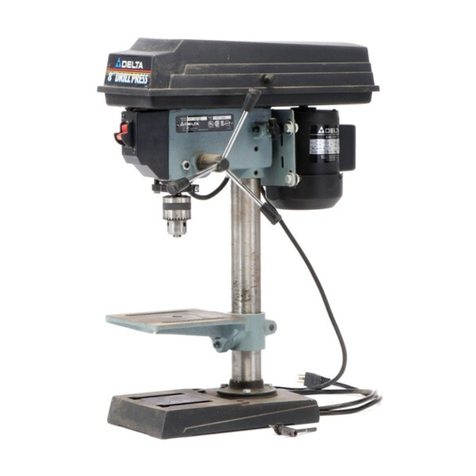
Delta
Delta 11-950 User manual
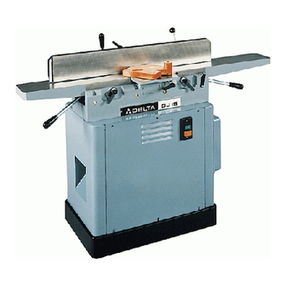
Delta
Delta DJ-15 User manual

Delta
Delta E Series User manual
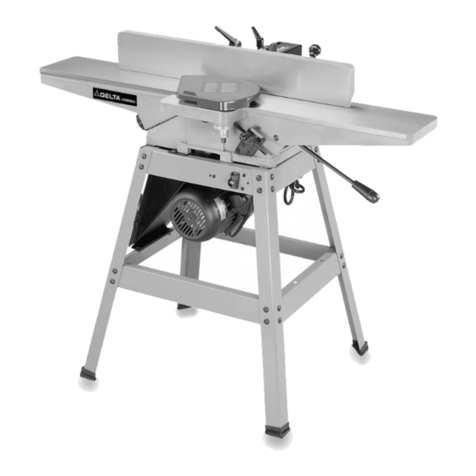
Delta
Delta Delta JT360 User manual

Delta
Delta 36-205 User manual
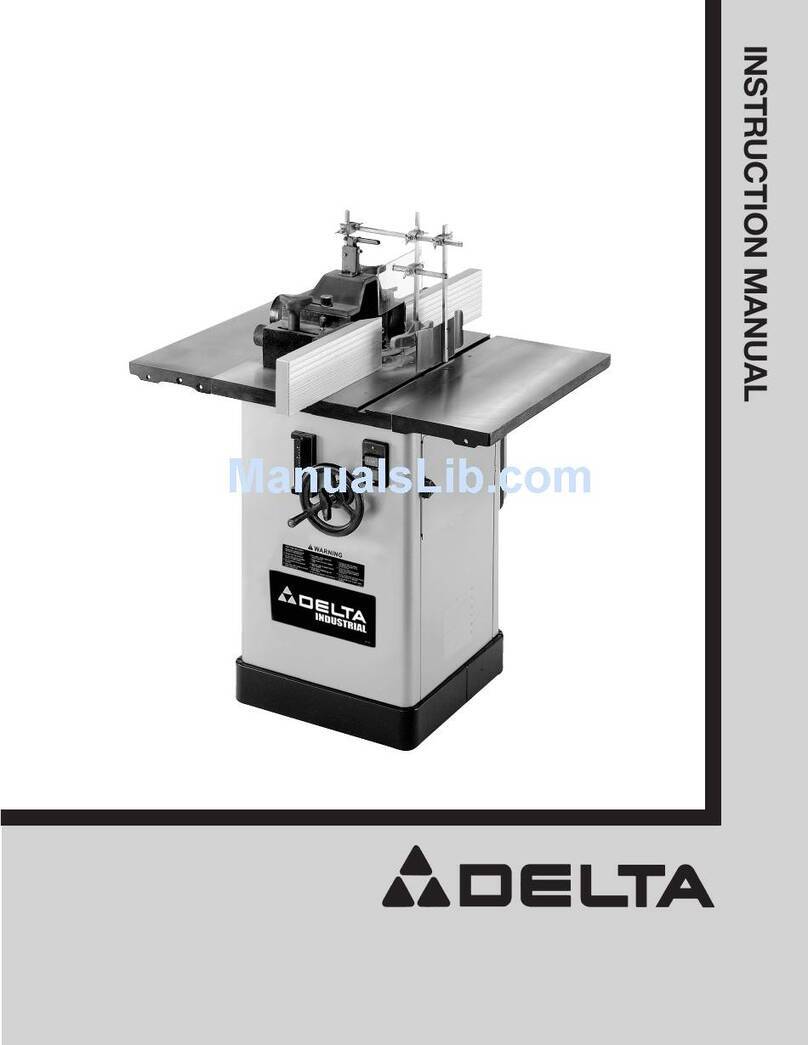
Delta
Delta 43-460 User manual
